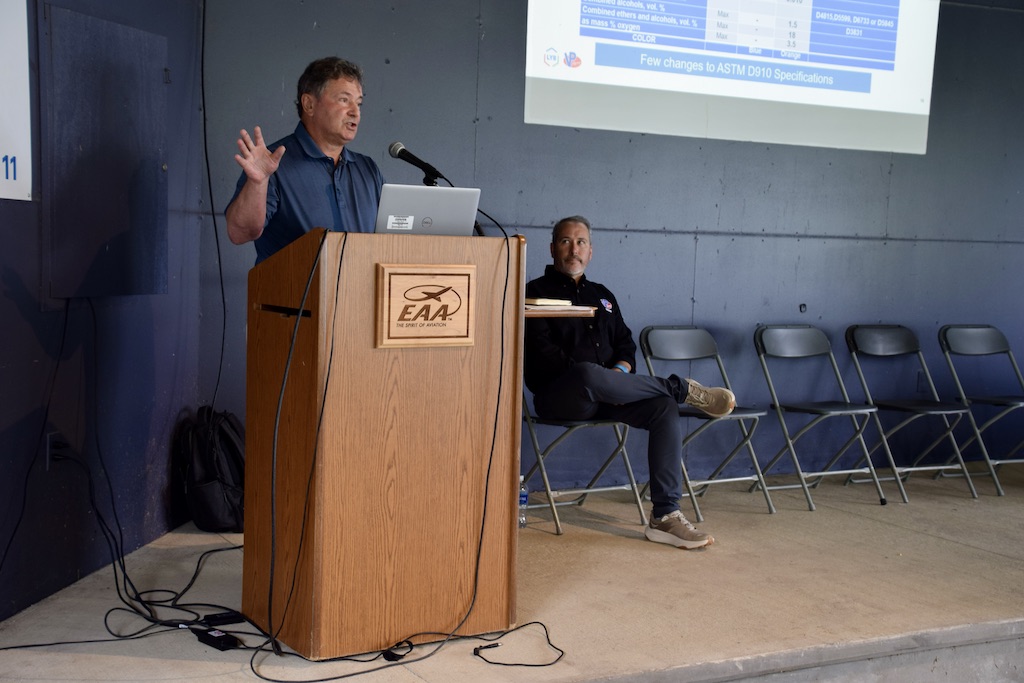
The Continental TSIO-550-K engine of a Cirrus SR22T was displayed at EAA AirVenture Oshkosh.
Certain paper and technical modifications will have to be made to ensure that a new high-octane unleaded fuel works across the entirety of the U.S. piston-engine aircraft fleet, says the developer of a leading fuel candidate.
“There is no such thing as a drop-in unleaded fuel to replace 100 Low Lead,” said Dan Pourreau, business development manager with LyondellBasel Industries. “We thought initially we were going to be able to do that, but we discovered we can’t do that either.”
Speaking July 24 at EAA AirVenture Oshkosh, Pourreau provided an update on UL100E, a high-octane unleaded avgas that is undergoing full-scale engine and airframe testing under the FAA’s Piston Engine Aviation Fuels Initiative (PAFI). LyondellBasel, a multinational chemical company, partnered with San Antonio-based VP Racing Fuels in 2018 to develop the fuel in response to an FAA call for new unleaded fuel offerors. Earlier fuel candidates from other companies had failed to meet PAFI’s criteria.
The fuel from LyondellBasel and VP Racing in late 2023 was the first formulation to pass a critical 350-hr. durability test in a turbocharged Continental TSIO-550-K piston engine and advance to full-scale testing under the PAFI program, which dates to 2013-14. Over the course of its development, the team learned that replacing 100 Low Lead (100LL) with a new high-octane unleaded fuel that would work in every engine and aircraft without making changes—PAFI’s original objective—is not possible, Pourreau said.
“The main reason is the vast majority of the engines and aircraft that are certificated today were certificated on 100 Low Lead with a MON (Motor octane number) of about 104,” he said. “If you take lead out or you don’t use manganese or other octane boosters, the best you can probably do is roughly 100 MON or above. If you estimate what an unleaded fuel MON would have to be; it would have to be probably 104 and possibly more—106 MON. It is just virtually impossible to do that without changing other properties [of the fuel] so much, it’s no longer practical and effective.”
Meeting the FAA and PAFI goal to "leave no plane behind” with a fleetwide unleaded avgas will require relatively minor “paper mods” by engine manufacturers to operating conditions such as cylinder head temperatures and pressure altitudes, Pourreau said. Engines that cannot safely operate with paper mods will require technical or mechanical modifications, the extent of which are being investigated by the FAA and industry Eliminate Aviation Gasoline Lead Emissions initiative.
UL100E Development

The higher the octane rating of a fuel, the higher its ability to withstand compression in an engine without detonating. The fuel additive tetra-ethyl-lead is used as an octane enhancer in 100LL, the most common type of avgas.
In its development of UL100E unleaded avgas, LyondellBasel started with a hydrocarbon blendstock and replaced the aromatics, a blend component that improves octane rating, with Ethyl tertiary butyl ether (ETBE), an oxygenate derived from ethanol that is also an octane enhancer. The company is a leading producer of ETBE, Pourreau said.
LyondellBasel has also tested Methylcyclopentadienyl Manganese Tricarbonyl (MMT), another type of octane booster. MMT has been approved for use in small quantity in automobile fuel but is known to leave manganese-containing deposits on engine and emissions system components.
“Our fuel is about 100 MON without octane boosters,” Pourreau said. “We looked and have continued to look at manganese—MMT—as a potential octane booster because we were trying to go to that mythical 104 MON. But the FAA has kind of reined us back in, saying they’re a little too concerned about the deposits that come from MMT. At this point we’ve reduced the MMT level. Initially we looked at levels like 75 milligrams manganese per liter; we’ve reduced that to about 10.”
He added: “We’re in the initial stages still of testing. The final fuel will probably not have it, that would be my guess. But it’s still included in the testing protocol.”
The physical and chemical properties of UL100E “are nearly identical” to those of 100LL, Pourreau said. It is fully miscible, or mixable, with 100LL and meets most requirements of ASTM D910, the industry standard specification for avgas.
Concurrently with pursuing an FAA fleet authorization through the PAFI testing program, LyondellBasel and VP Racing are pursuing an ASTM test fuel specification for UL100E. The draft specification and a research report were submitted for review through the ASTM ballot process in May and received 63 affirmative votes, five negative votes, and 219 abstentions. The team will address negative comments and re-ballot a new specification later this year, Pourreau said.
The team says it has completed the first phase of ASTM D7826 materials compatibility testing of UL100E. Purdue University’s National Test Facility for Fuels and Propulsion conducted initial materials compatibility testing of the formulation to determine how it interacts with metals, elastomers such as O-rings and hoses, plastics, sealants, bladder materials and paint, Pourreau said.
Lack of information on materials testing of another unleaded fuel candidate—General Aviation Modification Inc.’s (GAMI) G100UL—has proven to be a stumbling block to industry acceptance, though the FAA granted GAMI supplemental type certification (STC) approval of its fuel for use in all spark-ignition piston engines in September 2022.
Unlike the industry-government PAFI program, the STC process is proprietary between the FAA and the fuel developer. And GAMI has not pursued a fuel specification through the ASTM process.
“Materials testing is critical because that’s what may have caused many of the previous PAFI fuels to fail,” Pourreau said. “The composition has to change to get the octane, and when the composition changes the physical and chemical properties of the fuel can change significantly. The chemistry has to be compatible not only with 100 Low Lead but with the materials of a fleet that spans over 70 years of technologies.”





